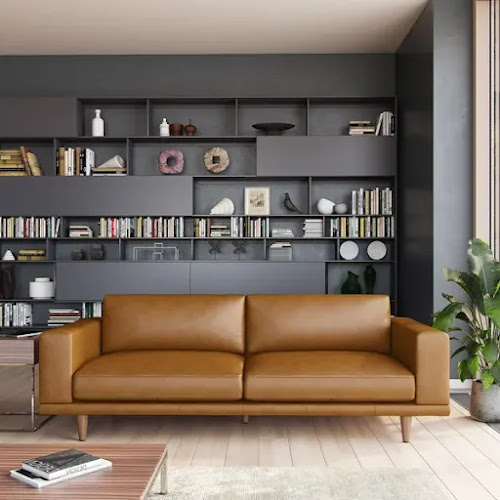"Elegance is not about being noticed, it's about being remembered – and nothing leaves a lasting impression like leather furniture."

Leather furniture has long been associated with luxury, comfort, and timeless sophistication. Whether you’re decorating a cozy living room or a professional workspace, leather furniture elevate the ambiance with a rich aesthetic and practical benefits.
In this blog, we explore why leather furniture is a smart choice for your home and office, diving into its specifications, usage benefits, prestige factor, global brands, and maintenance tips.
🔍 What is Leather Furniture?
Leather furniture is crafted from tanned animal hides, most commonly from cows. It is then processed, dyed, and treated to make it durable, soft, and stylish. Types of leather used include:
- Top-Grain Leather – High quality, slightly corrected

High-quality leather with a smooth, refined finish. Slightly corrected for a consistent look while retaining natural durability and softness. Ideal for premium furniture and accessories.
- Full-Grain Leather – Most natural and premium
The highest quality leather, known for its natural texture, unmatched durability, and luxurious finish. It retains the original grain, making it the most authentic and premium leather available.
- Split Leather – Lower layer of the hide, more affordable
Made from the lower layer of the hide, split leather is more affordable and offers a suede-like texture. Ideal for budget-conscious buyers seeking a leather alternative with a softer finish.
- Bonded Leather – Composite of scraps and fibers
Bonded leather is a material made from leftover leather scraps and fibers, blended with polyurethane and bonded to a fabric backing. It offers the look of genuine leather at a more affordable price.
🏠 Why Leather Furniture is Ideal for Your Home
1. Aesthetic Appeal
Leather sofas and recliners add warmth and class. Available in shades of brown, black, tan, and even white, they complement all design styles—from classic to contemporary.
2. Comfort That Improves with Time
Unlike fabric, leather breathes. Over time, it becomes softer and develops a charming patina, giving your furniture a lived-in elegance.
3. Durability
Leather can withstand years of wear and tear. With proper care, a leather couch can last 15–20 years or more, making it a worthwhile investment.
4. Easy Maintenance
A quick wipe with a damp cloth is often enough. Leather resists spills, dust, and allergens better than most fabric types.
🏢 Why Leather Furniture Works in Offices
1. Professional Image
Nothing screams “executive” like a deep brown leather armchair or a black leather sectional in a client-facing meeting room. It instantly communicates success, trust, and style.
2. Comfort for Productivity
High-back leather chairs with lumbar support enhance posture and reduce fatigue—key for 8+ hour office days.
3. Low Maintenance in High-Traffic Areas
Leather office furniture is easier to keep clean and germ-free, especially useful in shared spaces like lobbies or co-working areas.
🏆 Pride of Ownership
Owning leather furniture is often considered a symbol of prestige. It’s not just about comfort or aesthetics—it reflects a lifestyle of luxury and smart living. Especially when it comes from renowned brands, it becomes a status symbol.
🌍 Global Leather Furniture Brands
Here are some of the most recognized leather furniture brands across the world:
| Brand Name | Origin | Known For |
|---|
| Natuzzi | Italy | Designer leather sofas and sectionals |
| La-Z-Boy | USA | Recliners and ergonomic leather chairs |
| Chesterfield | UK | Iconic tufted leather sofas |
| Roche Bobois | France | Contemporary luxury leather collections |
| Poltrona Frau | Italy | Handcrafted premium leather furniture |
| Ekornes (Stressless) | Norway | Ergonomic leather recliners. |
🧼 Maintenance Tips for Leather Furniture
While leather is durable, following these simple steps ensures it stays beautiful for years:
🔹 Do’s
-
Dust and vacuum regularly
-
Use a damp, soft cloth for routine cleaning
-
Condition the leather every 6–12 months
-
Keep away from direct sunlight and heaters
🔸 Don’ts
Avoid harsh cleaners or alcohol-based wipes
-
Don’t allow spills to sit too long
-
Avoid sharp objects or pets scratching the surface.
📊 Leather Furniture Specifications
| Feature | Details |
|---|
| Material Types | Full-grain, top-grain, bonded leather |
| Color Options | Tan, brown, black, white, grey |
| Average Lifespan | 15–25 years |
| Best Usage | Living room, office, reception area |
| Care Level | Moderate (condition occasionally) |
| Texture Options | Smooth, pebbled, suede-finish. |
Conclusion: Is Leather Furniture Right for You?
Leather furniture is more than a decor choice—it's a statement of quality, taste, and durability. If you're seeking timeless elegance combined with comfort and minimal maintenance, leather is the perfect investment for both home and office spaces.
So next time you're redecorating or upgrading your interiors, consider the unmatched allure of leather.






.jfif)







.jpg)

























.jpg)




